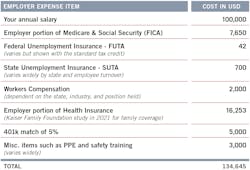In the last year, the term “quiet quitting” went mainstream globally. In social media, the term was defined and redefined. In short, it means doing the bare minimum required for the job, and not taking on additional tasks. While that may appeal to some individuals, it does not bode well for the team environment that most maintenance professionals operate in.
To that end, from a purely business perspective, what should your contribution be in terms of real money? When I share this concept in courses that I lead, most have never stopped to ponder the answer and are quite surprised at the exercise results.
Consider that you earn a salary of $100k annually in the U.S. Many hourly technicians earn this level of salary or more with their overtime. But that’s not your real cost to the business. Let’s break the actual cost down further by using some typical percentages. Your employer’s cost will vary based on the benefits they provide you.
The employer cost is an additional 35% of your annual salary. The percentage can range from a minimum of approximately 15% to 65% or more (see Figure 1).
As an aside, Klipfolio.com shows the 2022 Payroll to Revenue Ratio by Industry benchmark for manufacturing is 18% based on U.S. Census data and PricewaterhouseCoopers research. The percentage means that for every dollar of revenue, $0.18 is allocated to payroll expenses. The business also has other costs such as advertising and promotions, raw materials costs, logistics costs, and so on. Remember that revenue does not mean profit.
In discussing your contribution to the team and to the business overall, recognize that providing $135k of value is only covering your costs. At that level of contribution, you have added no additional value that enables the business to continue. While excess revenue and ultimately profit seem like dirty words in our world today, they are required to sustain the business going forward. Think about that new laser alignment system or infrared camera that was just purchased for your use. If everyone’s contribution only covers their cost, then there is no money to purchase those tools.
At this point, you might be asking what your contribution should be. The short answer is a multiple of three to five times. For some businesses, it is seven times your cost or higher. Using the previous example, this means that the contribution must be in the $400K-$675K range. Using the seven times multiplier, it is almost $1M. Improving your multiple separates you from the competition.
With those numbers, how will you make the contribution to the business objective? There are only three basic ways that you can add value to the business:
- Make the organization money by helping provide products or services.
- Find ways to save the organization money by reducing costs or downtime as examples.
- Develop something new for the business that adds value and benefits it.
Hopefully, you consider all three ways. Another tidbit to consider is with each downtime event, the profit that would have been made during that downtime period is lost forever and costs are increased.
Another change to consider is hybrid work and especially fully remote work. I have been to some sites where the planners only come into the office two times per week and in one case, the planner has not returned since the pandemic. How do you walk down jobs to create detailed job plans if you are not on the site?
Here is something that you may not have considered with regards to your value-add for the business in this case. If the position can work fully remote, there is someone out there in the world who has the same level or higher of education, lives in a less costly area, has similar experiences, and is willing to do the job for less. Controversial? Yes, but in a connected world, this becomes the reality. One does not have to look far for examples in other fields.
Bottom line, you set yourself apart by the value you bring.


